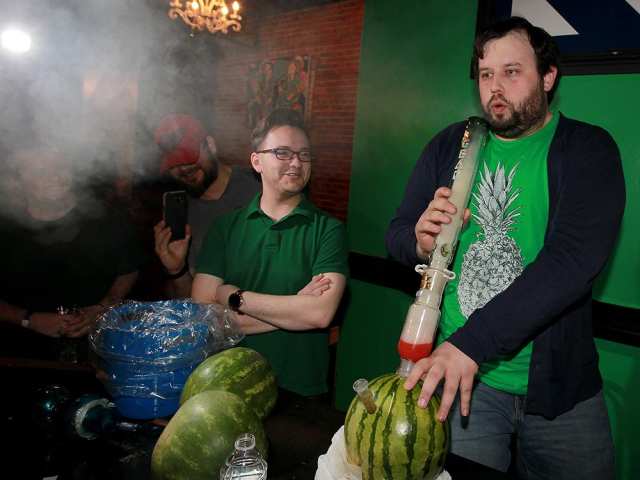Windsor Star – Dalson Chen – April, 21, 2016
April 20 brought the Canadian government’s strongest statements yet about the legalization of marijuana — and pot advocates at downtown Windsor cannabis lounge Higher Limits were already in a festive mood.
Smoking bongs, rolling joints, and enjoying music, pot advocates were in a festive mood at downtown Windsor medical marijuana lounge Higher Limits — and not just because of the date.
Considered a special occasion in cannabis culture, “4/20” took on even greater significance Wednesday when the federal minister of health told the United Nations that Canada will take steps toward legalizing marijuana by this time next year.

Jon Liedtke, co-owner of Higher Limits, said it couldn’t have been a simple coincidence that the announcement came on 4/20. “They knew exactly what they were doing,” Liedtke said with a laugh. “This is a government that really understands the power of symbols.”
In an impassioned speech at the United Nations, health minister Jane Philpott said Canada’s plan on pot will “challenge the status quo in many countries.”
Philpott said that in the spring of 2017, the federal government will introduce legislation to begin the process toward legalized and regulated cannabis, which she considers the best measure to protect youth while enhancing public safety.
She said Canada must improve its drug policy, but gave no other details.
Philpott’s words were welcomed by Liedtke, who has lobbied for progressive marijuana laws at the municipal, provincial and federal level. “This is the strongest indication from the federal government yet, in front of an international audience,” he noted. “It would be very difficult for the government to walk back on it at this point.”
Higher Limits was a busy place on Wednesday, with a full schedule of activities in recognition of 4/20. During the day, workshops were held on joint-rolling mastery and bong-crafting innovations.

Troy, a Detroit-raised man who didn’t want to give his last name, demonstrated how to make bongs out of fruit. It only took him 15 minutes to make a cannabis-smoking device out of a watermelon — which quickly attracted a lineup of tokers.
“Fruit is nice because it gives you creative freedom,” said Troy, who works for the government. “You’re getting a lot of flavour into the mix, as well. Kind of an infusion of flavour into the weed smoke itself. And, of course, it’s always a party pleaser.”
Other fruits that Troy found to be useful as bong material: apples, pineapples, papaya and lemons.

Jonah Komon, a 22-year-old Windsor resident, described Philpott’s announcement as “a tremendous step forward for Canada on the world stage.”
Komon said he needs medical marijuana to deal with his back problems: He was diagnosed with spinal dysraphism a couple years ago. “It’s a term for a broad spectrum of ailments in the spine. I have it in the L4 and L5 section of my spine, where it causes sporadic nerve pain,” Komon said.
“(Cannabis) relieves severe pressure and sudden pain that I experience throughout the day, which normal treatments such as Tylenol, Advil, and so forth do not help with.”
Cody Bueckert, another medical marijuana user with back issues, believes legalization is inevitable. “I think it’s about time. It should have been done a long time ago. I don’t think there should be any laws on marijuana. It’s a plant. It’s just like roses that grow in a garden.”

Fellow user Miranda Hart, 27, believes regulation of marijuana would be good for the economy: generating tax revenue, creating jobs, and even attracting tourism. “Canada could become a capital for pot tourism.”
But Liedtke cautioned against celebrating very hard this early in the process: It will likely take years for federal marijuana legislation to pass into law, there remain looming challenges for places like Higher Limits at the provincial level, and the Controlled Drugs and Substances Act stands unchanged.
“There are still people getting arrested for it. A moratorium on arrests is very necessary,” Liedtke said.

Why 4/20?
No, 4/20 is not Bob Marley’s birthday. He was born Feb. 6. Although the numbers 4/20 are widely recognized as holding significance in cannabis culture, the exact reason why remains hazy. We asked customers and staff at downtown Windsor’s Higher Limits their opinions on the origin of 4/20.
Miranda Hart: “I think it was when some people got together, and it went from there. A group of people just thought it would be a good time. I have no idea, to be honest.”
Cody Bueckert: “I ended up doing a little bit of research, just out of curiosity. From what I could find out, it came out of a really small town somewhere, I think in the mid-1970s. A group of kids wanted to go find a grow-op that was supposed to be near their town. So they met up by this statue at a government building, and they smoked some, and they were too baked to go find the grow-op. So they just kept coming back to that same statue. And their time was 4:20 p.m.”
Jon Liedtke: “There have been suggestions that after school, a group of stoners would meet up at 4:20 p.m. I think that’s when their detention ended… Honestly, for me, it’s not about the origin story. It’s just the fact that this is the day the cannabis community comes together. It’s a day that’s recognized.”


Leave a Reply